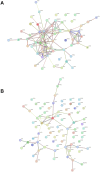This is a preprint.
Proteome-Wide Assessment of Clustering of Missense Variants in Neurodevelopmental Disorders Versus Cancer
- PMID: 38352539
- PMCID: PMC10863034
- DOI: 10.1101/2024.02.02.24302238
Proteome-Wide Assessment of Clustering of Missense Variants in Neurodevelopmental Disorders Versus Cancer
Update in
-
Proteome-wide assessment of differential missense variant clustering in neurodevelopmental disorders and cancer.Cell Genom. 2025 Apr 9;5(4):100807. doi: 10.1016/j.xgen.2025.100807. Epub 2025 Mar 11. Cell Genom. 2025. PMID: 40073865 Free PMC article.
Abstract
Missense de novo variants (DNVs) and missense somatic variants contribute to neurodevelopmental disorders (NDDs) and cancer, respectively. Proteins with statistical enrichment based on analyses of these variants exhibit convergence in the differing NDD and cancer phenotypes. Herein, the question of why some of the same proteins are identified in both phenotypes is examined through investigation of clustering of missense variation at the protein level. Our hypothesis is that missense variation is present in different protein locations in the two phenotypes leading to the distinct phenotypic outcomes. We tested this hypothesis in 1D protein space using our software CLUMP. Furthermore, we newly developed 3D-CLUMP that uses 3D protein structures to spatially test clustering of missense variation for proteome-wide significance. We examined missense DNVs in 39,883 parent-child sequenced trios with NDDs and missense somatic variants from 10,543 sequenced tumors covering five TCGA cancer types and two COSMIC pan-cancer aggregates of tissue types. There were 57 proteins with proteome-wide significant missense variation clustering in NDDs when compared to cancers and 79 proteins with proteome-wide significant missense clustering in cancers compared to NDDs. While our main objective was to identify differences in patterns of missense variation, we also identified a novel NDD protein BLTP2. Overall, our study is innovative, provides new insights into differential missense variation in NDDs and cancer at the protein-level, and contributes necessary information toward building a framework for thinking about prognostic and therapeutic aspects of these proteins.
Figures








References
-
- Wilfert AB, Turner TN, Murali SC, Hsieh P, Sulovari A, Wang T, Coe BP, Guo H, Hoekzema K, Bakken TE, Winterkorn LH, Evani US, Byrska-Bishop M, Earl RK, Bernier RA, Zody MC, Eichler EE. Recent ultra-rare inherited variants implicate new autism candidate risk genes. Nature genetics. 2021;53(8):1125–34. Epub 2021/07/28. doi: 10.1038/s41588-021-00899-8. - DOI - PMC - PubMed
-
- Sebat J, Lakshmi B, Malhotra D, Troge J, Lese-Martin C, Walsh T, Yamrom B, Yoon S, Krasnitz A, Kendall J, Leotta A, Pai D, Zhang R, Lee YH, Hicks J, Spence SJ, Lee AT, Puura K, Lehtimaki T, Ledbetter D, Gregersen PK, Bregman J, Sutcliffe JS, Jobanputra V, Chung W, Warburton D, King MC, Skuse D, Geschwind DH, Gilliam TC, Ye K, Wigler M. Strong association of de novo copy number mutations with autism. Science (New York, NY). 2007;316(5823):445–9. Epub 2007/03/17. doi: 10.1126/science.1138659. - DOI - PMC - PubMed
-
- Marshall CR, Noor A, Vincent JB, Lionel AC, Feuk L, Skaug J, Shago M, Moessner R, Pinto D, Ren Y, Thiruvahindrapduram B, Fiebig A, Schreiber S, Friedman J, Ketelaars CE, Vos YJ, Ficicioglu C, Kirkpatrick S, Nicolson R, Sloman L, Summers A, Gibbons CA, Teebi A, Chitayat D, Weksberg R, Thompson A, Vardy C, Crosbie V, Luscombe S, Baatjes R, Zwaigenbaum L, Roberts W, Fernandez B, Szatmari P, Scherer SW. Structural variation of chromosomes in autism spectrum disorder. American journal of human genetics. 2008;82(2):477–88. Epub 2008/02/07. doi: 10.1016/j.ajhg.2007.12.009. - DOI - PMC - PubMed
Publication types
Grants and funding
LinkOut - more resources
Full Text Sources
